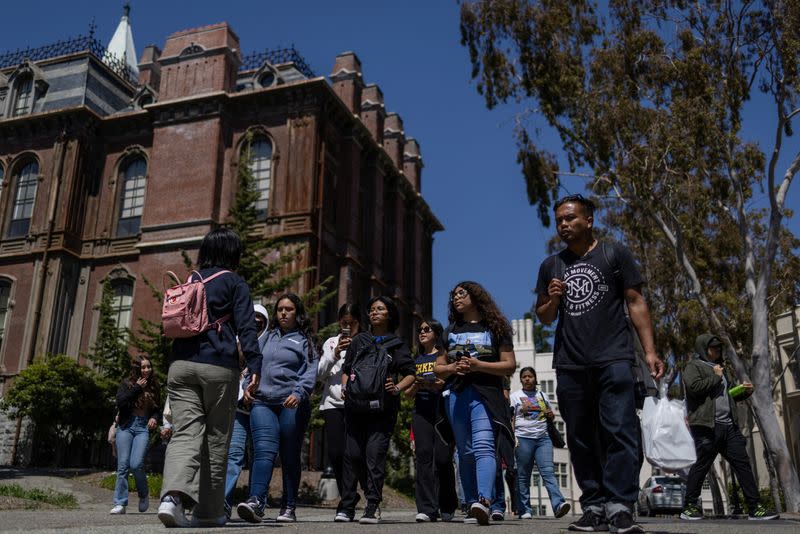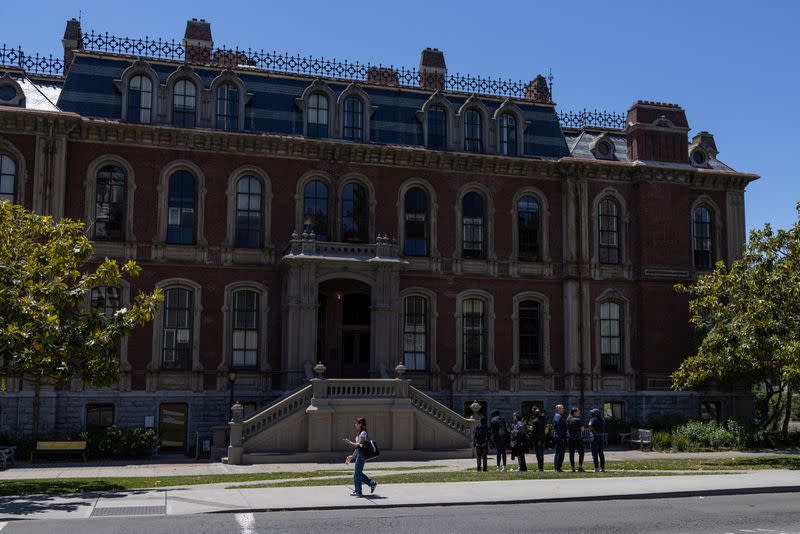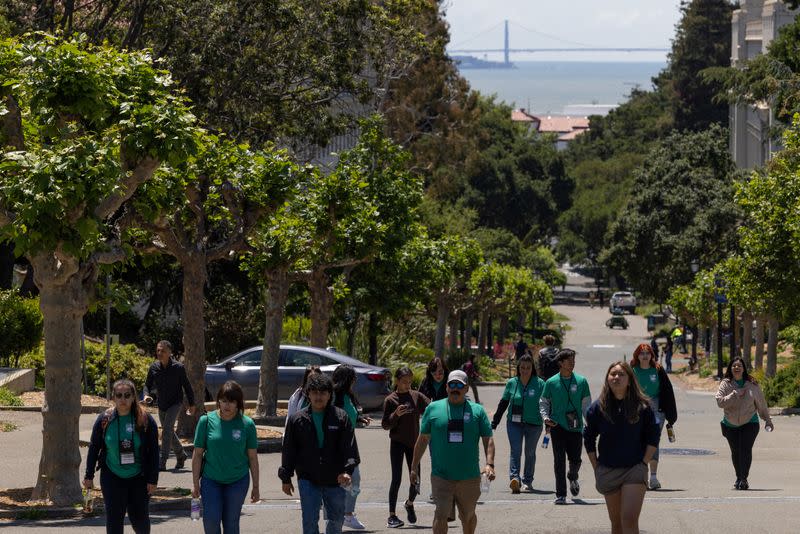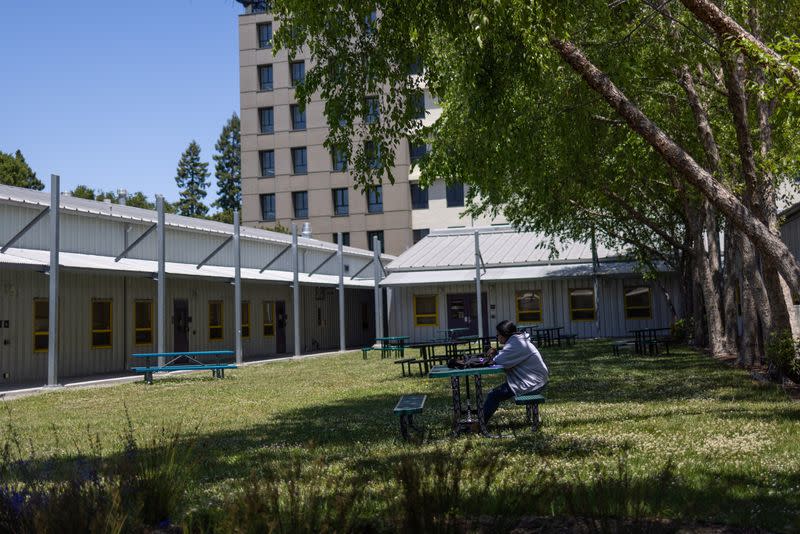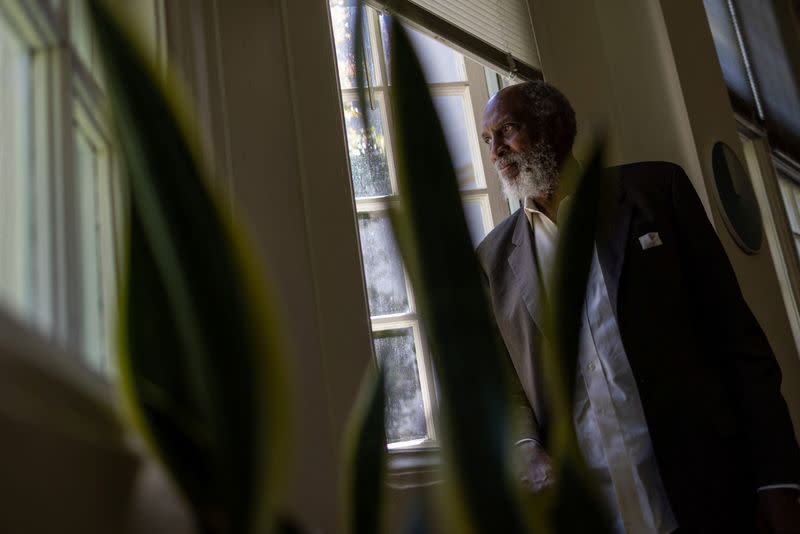How U.C. Berkeley tried to buoy enrollment of Black students without affirmative action
By Sharon Bernstein
BERKELEY, California (Reuters) - In the 25 years since California voters banned all consideration of race in college admissions, the state has spent more than $500 million to help create diverse student bodies across the University of California system - with some success.
Yet in classes at the University of California at Berkeley, philosophy major James Bennett, who is Black and Filipino, sees almost no one who looks like him.
"I've only met two other Black students within all of my classes that I've been in," said Bennett, who enrolled at the system's flagship school in 2021.
The U.S. Supreme Court is expected to rule this month in a pair of cases that could end affirmative action in college admissions nationwide. If that happens, universities that have used race-conscious admissions to boost enrollment of minority students will look to California, one of nine states that already prohibits such considerations at its public colleges.
California has pioneered race-blind efforts in college admissions by using factors such as socio-economic status and location to identify disadvantaged students, many of whom are from immigrant or diverse ethnic backgrounds.
Those efforts helped the state's top public colleges make up much of the ground lost in diversity in the years right after California voters passed the ban on affirmative action in 1996.
Black and Hispanic student enrollment at many U.C. campuses still lags the state's general population, however.
Berkeley, the system's most elite school based on high school GPA, offers the starkest example of the struggle to boost their numbers, particularly for Black students. In the fall 2022 freshman class, just 228 out of nearly 7,000 students - about 3% - identified as Black.
Femi Ogundele, Berkeley's associate vice chancellor of enrollment and dean of undergraduate admissions, who joined Berkeley from Stanford in 2019, said the U.C. system needed to better reflect the broader demographic breakdown of the state, one of the most diverse in the nation.
According to the latest census data, the state's population is 6.5% Black, 40% Hispanic, 35% white, 16% Asian and 1.7% Native American.
"I'm really proud of the gains we've had so far," said Ogundele. "But I would also say we have a lot of work to do."
The dearth of Black students has itself complicated recruitment efforts to expand their ranks, despite its distinction as the top public university in U.S. News and World Report's list of Best Global Universities, and the campus' reputation for progressive politics. Many Black families worry their students will feel isolated and opt to send them elsewhere, administrators and college counselors said.
Ogundele, who has made improving diversity a centerpiece of his work, came to Berkeley to bolster recruitment and diversity.
Senior Tyler Mahomes, a Black, Puerto Rican and white student from suburban Los Angeles, said he didn't realize before he arrived at Berkeley how few Black students would be there.
"When you come to campus, you see Black athletes on the walls and stuff like that, and it kind of almost creates this illusion of how diverse the campus is," he said. "But then when you get on the campus and you're one Black student in a class of 80 people, it's like, okay, what's going on? Where are more people that kind of look like me?"
RECRUITMENT EFFORTS
In the fall of 1998, after the Proposition 209 ballot initiative banning affirmative action went into effect, the number of Black and Hispanic students immediately dropped across U.C. campuses.
The impact was greatest for the system's two most selective schools, UCLA and Berkeley, where enrollment of Black and Hispanic freshmen was cut in half, the university system said in an amicus brief filed on behalf of the universities in the Supreme Court case in 2022.
Despite some improvement in the years since affirmative action was banned in California, the sparse presence of students from underrepresented backgrounds impacts the experiences of everyone on campus, the brief said.
"Many students from underrepresented minority groups, particularly those at UC’s most selective campuses, will often find themselves the sole student of their race and/or ethnicity in a class," the brief said.
With diversity still allowed as a goal, the universities focused on expanding the pool of applicants and on recruitment efforts aimed at enrolling minority students once they were admitted. Top students often have many choices of where to attend.
Outreach programs were set up to help prepare public school students for college and guide them toward applying, with particular focus on schools with high numbers of pupils of color.
At Berkeley, the state-funded bridges Multicultural Resource Center has worked to increase applicants from under-represented backgrounds and then offer food, counseling and other support once they arrive.
Allexys Cornejo, born to a teenage mom in a Salvadoran refugee family and a C-student in high school, said outreach from the bridges program while she was attending community college helped her get into Berkeley - and offered the support she needed to graduate this spring with a sociology degree.
Freshman enrollment of Hispanic students across the nine U.C. campuses stood at 27% in 2022, up dramatically from 15% in 1995 before affirmative action ended, but still well below population figures. Berkeley's figures last year were among the lowest in the system.
Black student enrollment across the system - which hovered at 3 or 4% for decades after the affirmative action ban - last year rose to 5%.
While other campuses in the system have struggled to enroll Black students, the issue has been particularly painful at Berkeley, which under affirmative action had exceeded the system overall in enrollment of Black students. Even with its efforts in recruitment and retention, Black students represented only 3% of the incoming 2022 freshman class, or about half of what they represented in 1995.
Asian students made up 43% of Berkeley's freshmen in the fall of 2022, up from 37% in 1995. White students accounted for 20%, down from 30% under affirmative action.
TOUGH ODDS
Exactly why Black and Hispanic enrollment has lagged at Berkeley is complex and not entirely known, administrators said.
For one, factors such as economics and a school's location are no longer as useful for recruiting Black students, Ogundele said.
While more than 500 California public schools are 40% Hispanic, fewer than 30 are 40% Black, he said. Social mobility, gentrification and immigration waves have changed the demographics of neighborhoods that once had larger Black populations, he added.
Financial aid is also an issue. Berkeley is competing with top private schools like Stanford or Harvard, which have large endowments and can offer more in scholarships, while also using affirmative action to admit students of varied ethnic backgrounds.
Sacramento-based college counselor Judith Painter said she recently worked with a high-achieving student from a disadvantaged Cambodian immigrant background who passed up both UCLA and Berkeley for Yale.
"But that's more the power of the brand than anything to do with UCLA or Berkeley," Painter said. "Yale is Yale."
UCLA, which has surpassed Berkeley in Black admissions in recent years, has tapped its broader pool of wealthy alumni who can help the public university offer more scholarships, said john a. powell, a law professor and director of Berkeley's Othering and Belonging Institute.
Last fall, Black students made up 7% of UCLA's freshman class, the same as before affirmative action was banned.
Berkeley does not have the same pool of wealthy and famous sports, entertainment and business figures among its alumni as Los Angeles - and some Black Berkeley graduates are hesitant to recommend the campus to young people who will find themselves in a small minority, he said.
His own daughter chose Emory University in Atlanta over Berkeley for graduate school because of her desire for a larger Black community.
Shereem Herndon-Brown, a college counselor and co-author of the book "The Black Family's Guide to College Admissions," said Berkeley's experience should serve as a warning to other schools of how they will struggle without affirmative action.
"They're trying their hand at equity, but it’s failing," he said.
(Reporting by Sharon Bernstein; Editing by Colleen Jenkins and Diane Craft)
